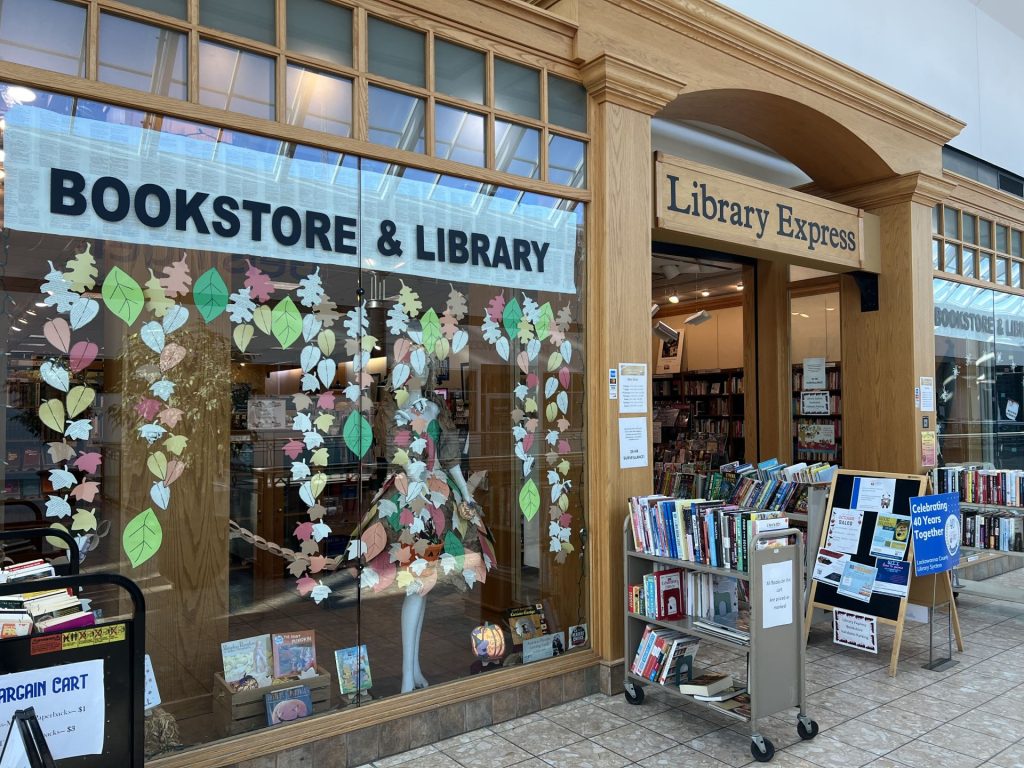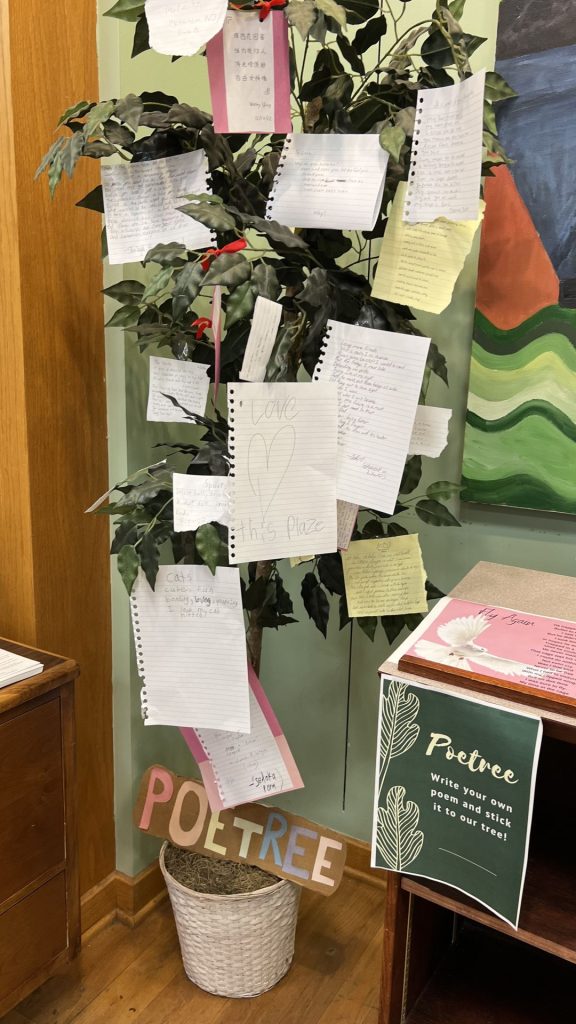Library Express: A Consumer-Driven Model
It’s a Saturday morning and you’re strolling the industrial white halls of the Marketplace at Steamtown, a fan of the hit TV Series The Office who just took a picture with the famous “Welcome to Scranton” sign from the opening theme, a Scranton local on the way to Crunch Fitness for your weekly 12-Round TKO class, or a parent with kids in tow waiting for the Electric City Aquarium to open. Further down the hall, you see some color breaking up the white and grey monotony, one of the only spots of visual activity at this end of the mall. As you get closer, you realize those are books carts out front, and you step a little quicker at the thought of browsing through the selection. The store’s window displays are creative and timely, bright fall colors and spooky paper spiders to match the current season, and the oak facade augmented with book pages as decoration is comfortable, orderly, and eye-catching. After perusing the used book carts out front and peeking at the event schedule on the accompanying whiteboard, you enter the store…

Located on the second floor of the Marketplace at Steamtown, smack dab in the heart of downtown Scranton, Library Express furnishes the community with color, accessibility, and creativity in a neat, orderly package. Before readers even enter the store, they can explore the loosely organized discount books on mismatched metal library carts by the entrance, divided by age range and general category (e.g., cookbooks, mass-market thrillers). These are the cheapest books in the store, with $1 used paperbacks and $3 used trade books.
Though the primary shelving in Library Express is nothing to scream home about—slightly battered, adjustable, walnut-colored shelves that occasionally look the slightest bit lopsided; plastic folding tables covered in paper; wire racks next to milk crates and pegboard—it certainly fills the need for practical functionality while avoiding a feeling of pretentiousness in the store’s presentation. Despite this purportedly pell-mell assortment of shelving, the store still achieves a uniform appearance and layout that is easy to grasp and maneuver through the moment you step into the space.

Along the walls on either side, sections are organized into small, contained U-shapes of similarly coded books: classics and classic-adjacents, adult and YA, nonfiction and special interest, etc. Although this store design is somewhat formulaic (U-shape after U-shape after U-shape with tables down the middle and little to break up the repetition), you don’t need to be familiar with the store to figure out where to find things or recognize what it’s about as a branch of the Lackawanna County Library System and an independent bookstore.
Library Express seems to borrow much of its layout from typical shopping mall outlets, presenting its wares in straight, orderly lines and the U-shaped “cubby” sections on either side of the space. In “The Science and Recent History of Bookstore Design,” Lyndsie Manusos meditates on “how a bookstore should ‘reflect the style and traditions of its surroundings’” when forming its culture, design, and function within its community. With its position in a former shopping mall and aging industrial town, Library Express definitely exudes that same straightforward, businessy atmosphere that pervades the rest of Scranton. It’s direct and to the point—you quickly recognize where to go to find the books you’re interested in, you can see straight through to the back of the store the moment you walk in, and while the layout encourages browsing and free movement, it doesn’t give you leave to linger for hours while reading an unpurchased or unborrowed book. In this vein, the store “buys into” that consumer culture with its prominent merch tables cutting through the center and the NYT Bestseller display right up front just past the book carts for anyone who wants to keep up with the current rankings.
In addition to the regimented orderliness of its design, notice, too, the distribution of Library Express’s three main product sections in the following floorplan. The bookstore is roughly divided into thirds, resulting in a large merch section in the middle of the store that clearly reveals the influence that traditional mall shopping culture and profit-minded sales models have had on the bookstore’s development. A brief color key: books for borrowing and other library spaces are in purple, non-book items for sale are in orange, and books for sale (new and used) are in green.
Library Express’s floor design and allocation of space is also revealing in terms of its collection. In Reluctant Capitalists, Laura Miller argues that “aside from any personal attachment to a locale, the [book]store proprietor knows that the fate of her entire business is tied to the future of that community” (226). In other words, independent booksellers have a stake in upholding the community’s well-being and must cater to their customers’ interests and values to stay afloat in that community. Library Express does this in many ways by prioritizing certain genres or categories over others. For example, the cheapest books are the first things customers from the low-income community of Downtown Scranton interact with.
In terms of relative section size, Library Express frontloads the store with classics and nonfiction, while compressing all of adult fiction, memoir, and young adult into just one U-section. Classics are the only section that requires two rows of books on every shelf to accommodate the large selection and the nonfiction section overflows into used book crates on the floor. Meanwhile, YA and adult fiction is the section with the smallest number of face-out books because there’s only enough room for them to be packed in spine out due to how compressed their allotted space is, whereas the children’s books are given a lot of breathing room.

The library collection of the hybrid bookstore is also remarkably small, less than a quarter of the store’s floor space. It does contain, however, a huge assortment of large print texts that really is a testament to its specialization and dedication to accessibility in the community (the large print titles take up almost an entire wall of the library section, where space is a premium), as well as hundreds of DVDs library card holders can take home and enjoy for the standard two week period before returning. The library portion of the store seems less a resource for high academic pursuits and more a place for older individuals in Scranton’s aging population to stop by to pick up a movie or a relaxing afternoon read, which lines up with the store’s huge emphasis on community engagement and activities in the back part of the store.
Library Express, as influenced by the industrial, no-nonsense shopping culture in Scranton, is a store that calls back to (or never left) the days when bookstores operated on practical commercial business models, more of a transactional retailer than an intellectual gatekeeper (a model well-suited to the environment around it). By prioritizing its customers, Library Express brings a lot of life to the Marketplace at Steamtown with its colorful arrays, creative art displays, and emphasis on community involvement. It’s committed to positively impacting anyone who enters through its library resources and bookstore design.
Citations
Texts
Manusos, Lyndsie. “The Science and Recent History of Bookstore Design.” BOOK RIOT, 22 Feb. 2022, bookriot.com/the-science-and-recent-history-of-bookstore-design/.
Miller, Laura J. “Pursuing the Citizen-Consumer: Consumption as Politics.” Reluctant Capitalists: Bookselling and the Culture of Consumption, University of Chicago Press, Chicago, 2007, p. 226.
Images/Graphics
All photos taken by Amelia Alexander, Brooke Nelson, and Janina Reynolds on October 28, 2023 at Library Express Bookstore, Scranton, PA.
Floorplan drawn by Amelia Alexander in October 2023; floorplan annotations added using https://www.thinglink.com/

0 Comments